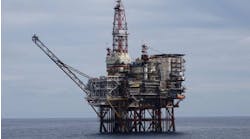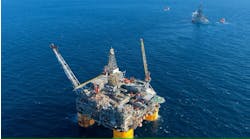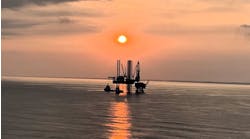Jeremy Beckman
London
Crew on the Amerada Hess-operated Scott platform preparing for the Telford well tie-in.
Third platform planned for Troll
Fifty subsea horizontal wells, including 12 multi-laterals, are proposed for the latest phase of the Troll area development. Operator Norsk Hydro has submitted a NKr15.9 billion PDO scenario to Norway's Energy and Industry Ministry based around a new floating production platform, Troll C, with modifications to the existing Troll B platform.
The partners aim to produce 1.164 billion bbl in total from the Troll West Oil province, where oil layers are 24 meters thick, and from the Troll West Gas province, where oil layers measure 12 meters. Nine groups of wells would be completed. Crude from the three southern clusters would head to the Troll B platform for processing and onward to Mongstad via the existing oil line. Oil from the six northerly well groups would be routed to the new Troll C platform for processing, then piped to shore through a new line. Around 46 bcm of associated gas would be treated on the Troll A installation.
Following experience from the Troll B development, Hydro is aiming at 2.5 km-long horizontal wells drilled from multi-slot templates. Kvaerner, which is bidding a steel-hulled semi for Troll C, will not want to repeat its experiences with the Troll B concrete semi. The cost overruns were a disaster for the company, said Tore Bergesen, exceutive vice president for Kvaerner Oil & Gas. Kvaerner Oilfield Products has definitely been pencilled in for the trees, wellheads, and other subsea components for the new project.
Hydro's modest (by comparison) Oseberg East PDO has just received Norwegian government blessing. The NKr3.3 billion project is driving towards start-up in October 1998 via a conventional platform and a new 27 km oil line to the Oseberg Field center. Reserves are estimated at 144 million bbl.
Barents blocks opened to bidders
Norway's Industry and Energy Ministry has imposed a deadline of February 5 for applications for 45 blocks available under the Barents Sea Project. The blocks are spread across six different parts of the sea, and will initially be defined as seismic areas: production licences will be determined at a later date.
Although reserves in the sea are put at 5.2 billion boe, no commercial oil discoveries have yet been made. Drilling levels in the region have slumped this decade, and Statoil recently pulled out of Barents production licence 201 in the Troms area. However, Statoil is joining a consortium of six oil companies bidding for the new blocks.
Nominations were due early this month for offshore areas to be included in next year's Faroese exploration licence round. Around 20 companies are thought to be interested. New geological data should be gleaned from the recently deepened onshore Lopra-1 well. However, completion was delayed a few weeks by a stuck drill/string which eventually necessitated a side-track, adding NKr 12 million to the NKr 28 million budgeted for this DONG-operated well.
Gas strikes resume off Netherlands
Both NAM and Clyde report successes on the Dutch shelf. Jackup Neddrill 9 tested gas at 29.8 MMcf/d for Clyde from well M7-5. The operator expects to apply soon for a production licence. NAM also found gas through a horizontal well deviated four km from the shoreline near Lauwersoog into the Wadden Zee, and was expected to drill a follow-up well from the same location. Despite this sucess, Hans Wijers, the Dutch Minister of Economic Affairs, will not rescind a decision to limit exploration and production of gas in the Wadden Zee. At the other end of the field life cycle, NAM director Jan Oele has predicted that 40 redundant offshore installations will have to be removed from the Dutch sector over the next decade.
Agreement clinched for gas route
Sales gas from the planned Shearwater and Elgin/Franklin developments in the UK Central North Sea will be piped to existing reception facilities at Bacton, Norfolk. Condensate will be exported via existing infrastructure, but a third product stream transmiting chemicals feedstock may be routed through a new pipeline link into the CATS system to Teesside, if demand warrants it.
Disagreements over the gas landfall site were in theory putting Shearwater at risk, but after government approval for Bacton, operator Shell immediately came out with fabrication awards for the platform to UK-based yards. However, the decision disappointed British Gas which had planned a new long-distance, high pressure pipeline tracking down the east coast from Teesside to link into the new line.
Shell is currently the dominant UK developer, also announcing subsea schemes for the Mallard and Kingfisher Fields (covered elsewhere in this issue). Still in the central sector, Shell operates Block 29/1a which contains a new mid-size oil discovery, known as Abbot, which also stretches into Amerada Hess-operated 29/1b. Amerada, meanwhile, has just brought onstream the subsea Telford Field at 10,000 b/d through one production well tied back to the Scott platform.
Foinaven riding the storms
BP's Foinaven Field west of the Shetlands should start producing oil next March or April, said project manager Dave Brookes at the recent IOCE conference in Aberdeen. This would be 29 months after project sanction - somewhat later than the field partners originally anticipated. Most of the problems have been man-made, but the region's notorious weather conditions also played their part, said Brookes.
During 1995, a 10-meter significant wave crashed through the moonpool of the installation semisubmersible Iolair, damaging one of the risers. Torque-induced twists in the pipelines had to be overcome by attaching wings on the side of the flowline termination assemblies.
Unexpected hitches included a lost-water injection line during reel lay, due to an unequal section in the reel, and most crucially, leaks in the drilling center (DC1) manifold, only discovered this May, five months after the installation. The manifold had to be retrieved from the seabed for investigations. The fault was eventually traced to the cathodic protection system, with the DC2 manifold being switched to the DC1 site. Brookes described this as probably the Foinaven project's major challenge, and personally his most difficult technical problem in 10 years as chief BP engineer. The new DC2 manifold should be in place in May, he added.
Copyright 1996 Offshore. All Rights Reserved.




